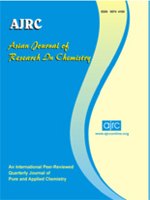Theoretical Prediction of Reactive Site of Aryl Halide for Suzuki Coupling Reaction
Subscribe/Renew Journal
The aryl c-c bond formation is accomplished via Suzuki coupling by treating aryl boronic acid with aryl halide in the presence of Pd (0) complexes and base. The reactivity order of aryl halide is I > Cl > Br for Suzuki coupling. If aryl halide containing different halogen atom as poly substitute, then it does not require any theoretical prediction for reactive side prediction of aryl halide since we know the order of reactivity but if aryl containing more than one same halogen atom in that case theoretical prediction will help us to predict the reactive side of aryl halide. In this work 2,3- dibromo pyridine and 2,5 dibromo pyridine reactivity towards Suzuki coupling is determined by charge density on bromine atom and bond order between the bromine and carbon atom. The aryl halide bromine atom having more electron density is readily reacting with Pd(0) complex in oxidative addition step and in the bond order respect, the aryl halide having smaller value of bond order (carbon halogen bond) is readily reacting with Pd (0) complex in oxidative addition step. The calculations were done semi-empirical level with PM3 Hamiltonian in RHF method.
Keywords

Abstract Views: 327

PDF Views: 1



